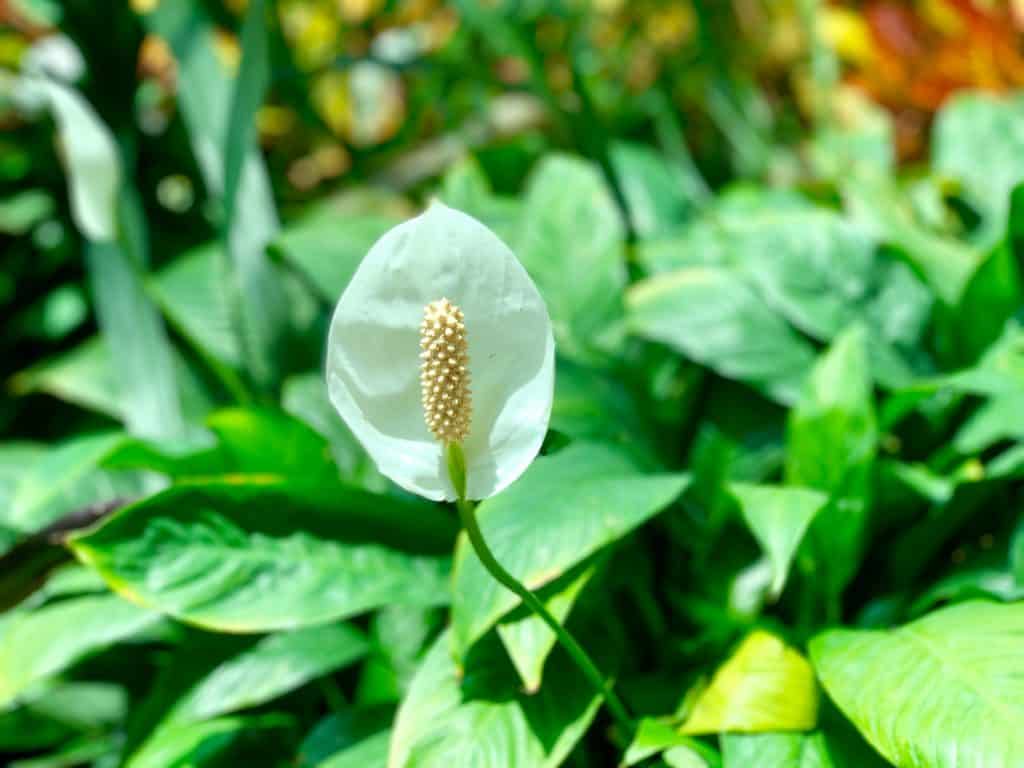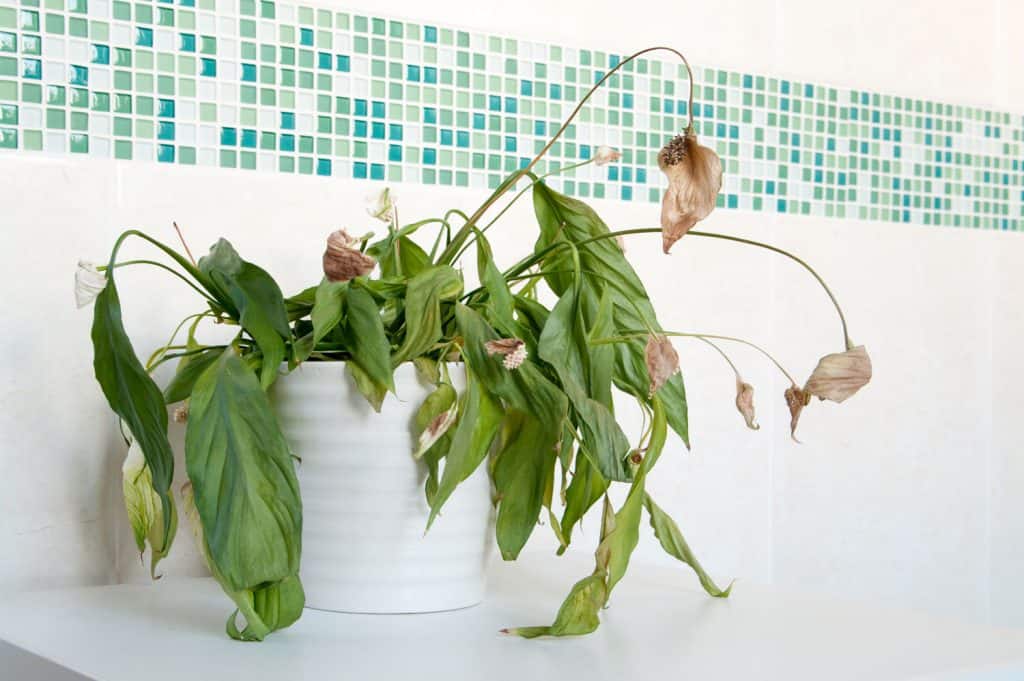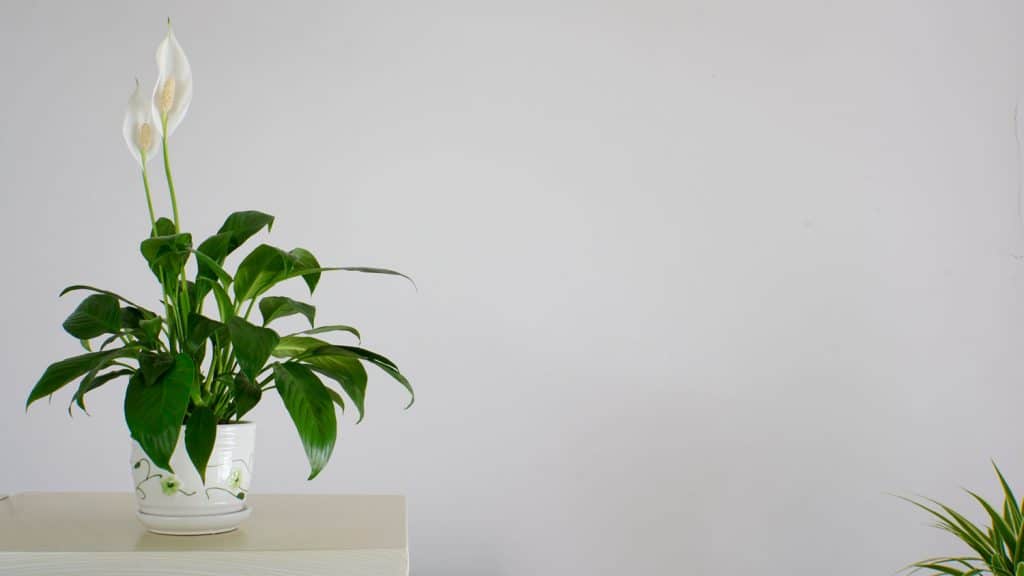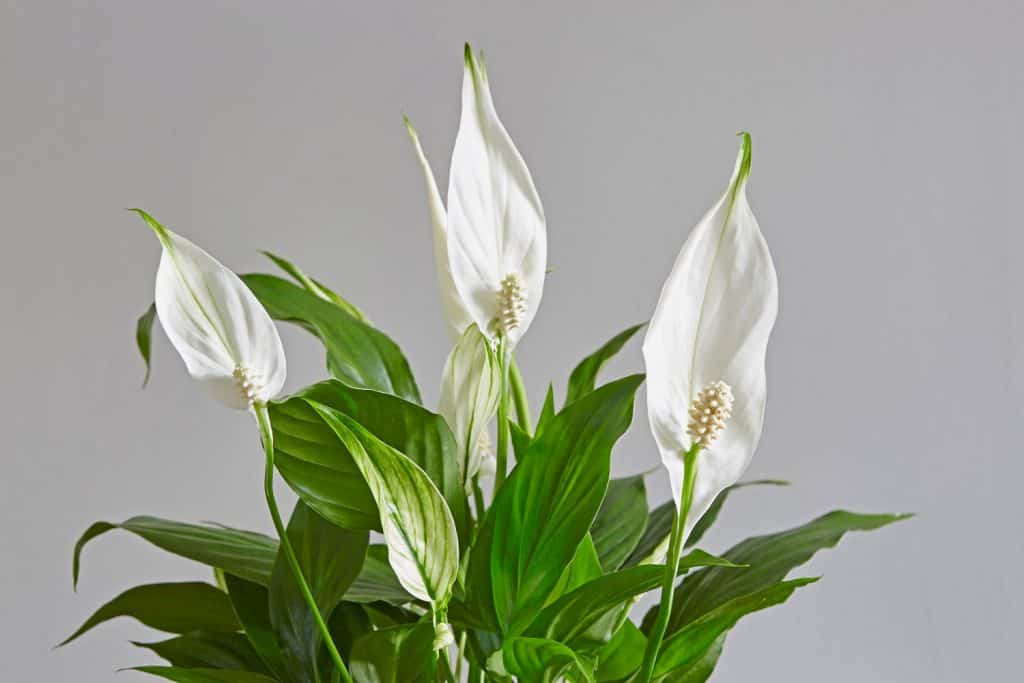Many houseplant lovers enjoy keeping a peace lily for its simple beauty, air purification capabilities, and low maintenance. However, if you notice a peace lily is drooping, turning brown or black, you may wonder if you can do anything. We researched common reasons a peace lily may be dying or in poor health and how to help revive the plant back to health.
If you notice that your peace lily appears to be dying, it may be due to the following reasons.
- High Stress
- Poor Drainage
- Overwatering
- Underwatering
- Poor Nutrition
- Incorrect Lighting
- Pests
- Disease
Don't fret, as most problems with a peace lily can be solved quickly. Read on to learn how to heal a peace lily back to its optimal state of health and beauty.

Revive A Troubled Peace Lily

A healthy peace lily usually has lush, green leaves and a few white flowers cradling a fascinating-looking pistil at its center. However, when a peace lily is not doing too well because of various environmental factors, its appearance and health will suffer.
The peace lily is an easy and popular indoor plant that lives happily in offices and homes in ideal conditions. It is critical to act quickly if you think your peace lily is dying. In most cases, you can soon revive a peace lily, as these plants are tenacious and forgiving.
Why Is My Peace Lily Suddenly Dying?

If you are new to the needs of your peace lily, some simple mistakes may be causing the plant to wilt, lose leaves, or turn brown. Check out our list of common reasons a peace lily may suddenly appear to be dying.
1. High Stress
Be careful with a peace lily as stress can be deadly. These beautiful plants love comfortable temperatures. Frigid temperatures below 41 degrees Fahrenheit or being placed next to cold draft are a problem. Leaves will turn black or yellow as a response to cold.
2. Poor Drainage
It is so important to use well-draining soil and containers for a plant to reduce the chance of root rot or attracting pests. Make sure to regularly check pots and decorative containers for excess water. The presence of root rot leads to a rank odor that is hard to forget.
If a peace lily has been sitting in poorly drained soil that is sopping wet for too long, it may be too late to save it from root rot. Use an optimal soil or potting mix ideal for a peace lily. Place the plant in a pot with drainage holes.
3. Overwatering
When a peace lily is getting too much water, it leads to leaves that turn yellow and begin to droop. Although the peace lily is a tropical plant, soil that is overly saturated and doesn't drain well can lead to a dying peace lily. Check the soil to make sure it is moist, not soaked.
Another reason leaves turn yellow is due to a nutrient deficiency, which a lack of nitrogen could cause. Be careful with fertilizing the soil, as too much fertilizer can cause yellow leaves. Reduce the frequency and amount of watering to remedy this problem.
4. Underwatering
Depending on the season, you will want to adjust the watering schedule for your peace lily. Not watering your plant enough can lead to black leaves. Also, over-fertilizing leads to excess salts in the soil, turning leaves black.
Check the soil of your peace lily now and then to make sure it is slightly moist and not bone dry. If the soil has been neglected for too long, it may end up repelling water. Fix this problem by adding nutrition to the soil and then submerging the plant in water.
5. Poor Nutrition
It happens; over time, watering soil can deplete nutrients that a plant needs to thrive. Check the soil if a peace lily shows delayed growth or discolored leaves. You want to add fertilizer to the soil as needed, as over-fertilization can kill the roots and leaves.
If you are uncomfortable adding nutrients to the soil or changing the soil mix, consider adding liquid fertilizer to the water. Also, be careful with the type of water you add to your plant. The pH level, any heavy metals present, or particulates can impact the soil.
6. Incorrect Lighting
The peace lily is a plant that thrives best under indirect bright light. If you notice streaks or brown spots on leaves, exposure to direct bright light is the likely culprit. The leaves of this plant can become scorched if left under the heat and glare of the sun for too long.
Consider placing a peace lily in a corner where there are fluorescent lights, or expose it to low or medium natural indirect light.
7. Pests
There are three main pests that love to dine on the peace lily and cause health problems. Check your plant for the presence of aphids, spider mites, or mealy bugs. If you notice holes on the leaves, your plant suddenly loses its healthy appearance overnight, work quickly.
You may need to enclose your peace lily in a plastic bag, wipe down the leaves and plant, or use a pesticide.
Read More: How To Get Rid Of Black Aphids [A Complete Guide]
8. Disease
When a disease has set in a peace lily, you may discover a foul smell coming from the soil, and the leaves will droop and become discolored. Check the soil and roots of the plant and apply a treatment as needed.
How Do I Know If My Peace Lily Has Root Rot?
If you catch the signs of root rot early, you may be able to bring your peace lily back from the brink of death's clutches. You will want to clean off the plant's roots, prune any heavily damaged roots, and apply a fungicide. Root rot often smells like a swampy sewer.
Make sure to change the pot for your peace lily and place the plant in fresh soil. Be careful about overwatering the plant or adding fertilizer until it has settled to reduce stress levels.
Check out this fungicide for plants on Amazon.
What Happens If You Over-Water A Peace Lily?

Be careful with the watering schedule for a peace lily. If you overwater this plant, you may end up with yellow leaves or a foul smell from the soil. A bad odor may indicate root rot, making reviving a peace lily nearly impossible.
Too much water may also attract pests and reduce the soil's nutritional content.
Should I Cut The Brown Tips Off My Peace Lily?
It is a good practice to cut off any brown or damaged areas of your peace lily to encourage new growth and reduce health problems. If leaves turn brown, make sure your peace lily is getting the right amount of lighting, water, and proper soil conditions.
Make sure to use sanitized pruning shears so as not to transfer anything harmful to the plant. If you notice more than half of a peace lily's leaves are brown, it's time to do some pruning and make adjustments to the watering schedule, soil and check for disease.
Check out these pruning shears on Amazon.
Will A Peace Lily Grow Back?

A peace lily is likely to grow back with a bit of love, care, and patience. However, if root rot has set in to the point the plant cannot be salvaged, it may be too late.
Keep in mind, anywhere a peace lily has a flower, that bloom will eventually die and need to be pruned. As long as a peace lily has some leaves and is healthy, eventually, new blooms will appear.
When Should I Repot My Peace Lily?

The best time to repot a peace lily is in the spring. Be careful with adding fertilizer after going up one pot size. Wait a minimum of two months before adding nutrients to the soil to reduce stress. Too much fertilizer can harm the soil conditions and injure the plant's roots.
Of course, if you notice your peace lily's roots are displacing the soil, you might not want to wait for spring to repot the plant. Be gentle with transitioning the plant to a new home and use similar soil conditions.
Check out this potting soil on Amazon.
Conclusion

We hope you feel more confident about reviving a troubled peace lily the next time you notice discolored leaves or signs of distress. Peace lilies are excellent plants for new and experienced caretakers because they are resilient, easy to maintain and look lovely.
Before you go, don't miss out on reading the following helpful articles.
Read More: 17 Indoor Winter Plants That Bloom With Gorgeous Flowers
Read More: Why Is My Dragon Tree Dying? [With Tips On What To Do About It]



